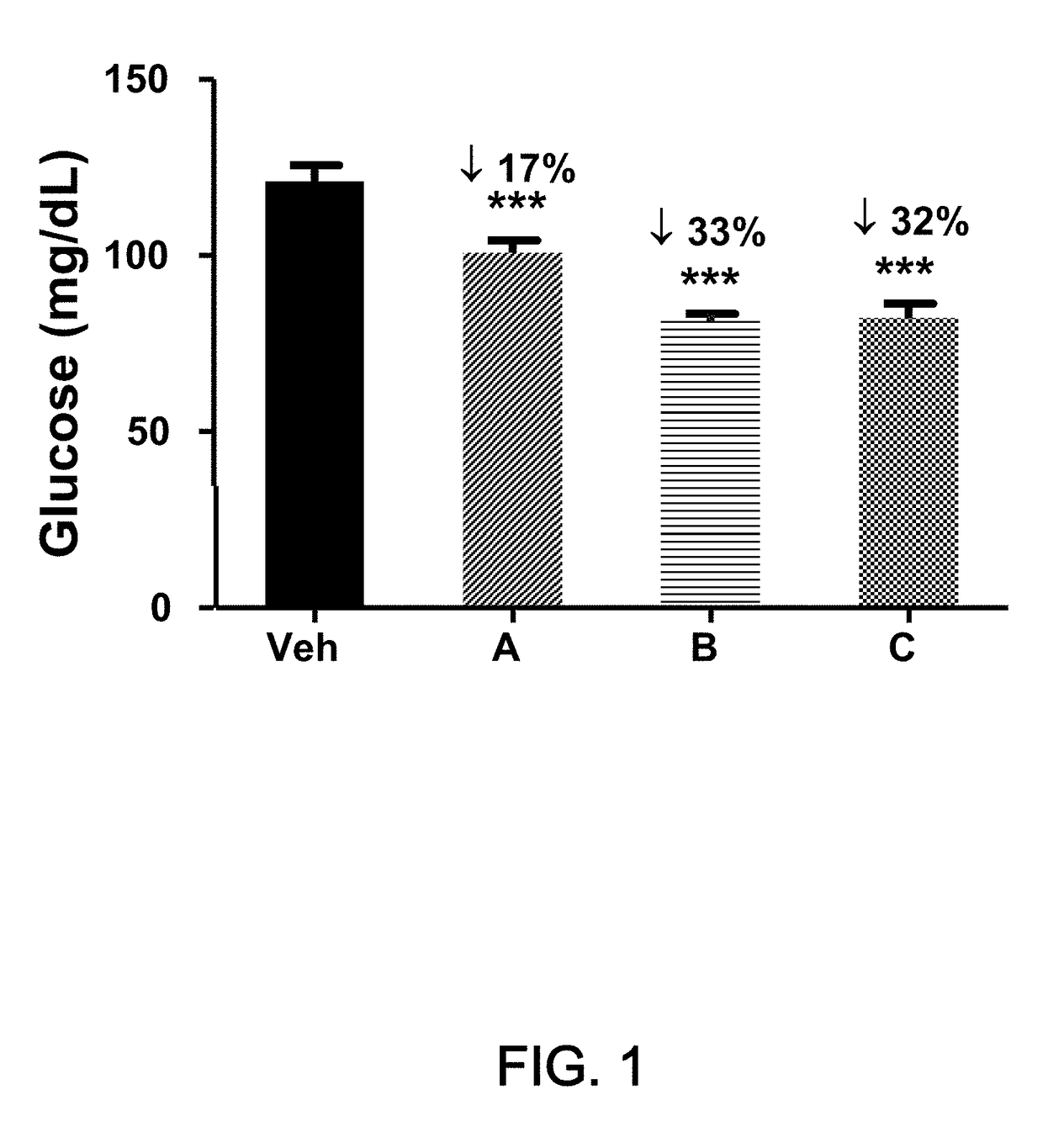Methods of treating diabetes by administering a glucagon receptor antagonist in combination with a cholesterol absorption inhibitor
a technology of glucagon receptor and cholesterol absorption inhibitor, which is applied in the direction of heterocyclic compound active ingredients, drug compositions, metabolic disorders, etc., can solve the problems of affecting (blurry) vision, excessive thirst, and varied symptoms, and achieve the effect of reducing hyperglycemia
- Summary
- Abstract
- Description
- Claims
- Application Information
AI Technical Summary
Benefits of technology
Problems solved by technology
Method used
Image
Examples
example 1
Sub-Chronic Treatment with GRA Increased Plasma Total Cholesterol and Phytosterols in hGCGR Mice
[0071]Methods
[0072]Male hGCGR mice (Transgenic Research, 8:295-302, 1999) at ˜12 wks of age maintained on chow diet were treated with vehicle and GRA Compounds A, B, and C at 30 mpk QD for 5 days (n=8). On Day 1, mice were administered the compounds followed by glucagon-induced glucose tolerance test. On Day 5, mice were fasted at 7:30 am. After dosing at ˜9:00 am, the blood glucose was measured at 2-h post dose with a glucometer; see FIG. 1. At 6-h post dose, the tail blood was collected for PK measurement. Mice were euthanized with CO2, and blood was collected by cardiac puncture. The liver was snap frozen in liquid nitrogen with a freezing clamp and saved in −80° C. Plasma was isolated by centrifuging the blood at 8000 rpm for 5 min. The plasma level of total cholesterol was measured by biochemical assay (Wako Chemicals Inc.). The plasma level of lathosterol and phytosterol was measure...
example 2
Similar Increase of Total Cholesterol and LDL-c Induced by Gras In Both Human and hGCGR
[0076]In the human Phase 2 h studies of GRA Compound D, plasma levels of total cholesterol and LCL-c were dose-dependently increased by Compound D during the 12-wk trial. Treatment groups are shown in FIG. 5 and are from left to right: (i) Placebo, (ii) 1 g BID Metformin, (iii) 20 mg Compound D, (iv) 40 mg Compound D, (v) 60 mg Compound D and (vi) 80 mg Compound D. As shown in FIG. 5, the % changes in total cholesterol and LDL-c tracked with each other. In hGCGR mice treated with vehicle, Compound A (surrogate of Compound D), or Compound T (Genes and Development, 14:2831-2838, 2000, an LXR agonist used as a positive control), plasma levels of total cholesterol and LDL-c were significantly increased by Compound A and Compound T comparing with vehicle; see FIG. 6. It is important to note that lipoprotein profiles of mouse and human are fundamentally different. In mice, the major lipoproteins are in ...
example 3
Parallel Comparison of Different GrAS on Plasma Phytosterols of hGCGR Mice
[0077]Methods
[0078]The same protocol was used for this study as described previously. Briefly, male hGCGR mice at 12 wks of age were treated with vehicle and GRA compounds Compound A, Compound F, Compound B, Compound C, Compound G, and Compound H. All compounds were dosed at 30 mpk QD for 5 days. Plasma total cholesterol, phytosterol, cholesterol absorption, and cholesterol synthesis were measured by using the same assays as described before.
[0079]Results
[0080]All GRA compounds—Compound A, Compound F, Compound B, Compound C, Compound G and Compound H showed an increase or a trend of increase in plasma phytosterols in hGCGR mice after sub-chronic treatment; see FIGS. 7A-C. Unlike humans, rodents are able to tightly maintain their plasma levels of total cholesterol and phytosterols. It is hard to develop phytosterolemnia in mice in all conditions. A relatively small increase of phytosterols in mice may translate...
PUM
| Property | Measurement | Unit |
|---|---|---|
| body weight | aaaaa | aaaaa |
| body weight | aaaaa | aaaaa |
| body weight | aaaaa | aaaaa |
Abstract
Description
Claims
Application Information
 Login to View More
Login to View More - R&D
- Intellectual Property
- Life Sciences
- Materials
- Tech Scout
- Unparalleled Data Quality
- Higher Quality Content
- 60% Fewer Hallucinations
Browse by: Latest US Patents, China's latest patents, Technical Efficacy Thesaurus, Application Domain, Technology Topic, Popular Technical Reports.
© 2025 PatSnap. All rights reserved.Legal|Privacy policy|Modern Slavery Act Transparency Statement|Sitemap|About US| Contact US: help@patsnap.com



